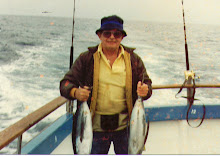Harlan County Lake in Alma, Nebraska, though, is higher than it has been in more than twenty years. It is filled by the Republican River, which flows (naturally) through Republican Valley and meets the dam built in 1954 by the Army Corps of Engineers at Republican City (population 199).
 I took this picture while fishing on the river yesterday (no fish, no joy). The Republican River is certainly not the Colorado, but it is a nice local waterway. It is as narrow as 20 feet and as wide as 200 feet, and at its deepest is probably 6-8 feet. It is carrying more water right now than most locals have seen in many, many years. One fella was telling me that less than five years ago during the summer, the river was dry - Not a drop of water in it.
I took this picture while fishing on the river yesterday (no fish, no joy). The Republican River is certainly not the Colorado, but it is a nice local waterway. It is as narrow as 20 feet and as wide as 200 feet, and at its deepest is probably 6-8 feet. It is carrying more water right now than most locals have seen in many, many years. One fella was telling me that less than five years ago during the summer, the river was dry - Not a drop of water in it.Why we have all the water is not clear to me yet, but between last year and this year additional rain on the river course has taken Harlan County Lake to dramatically higher levels. It's a delight to the local businesses because the word is out and we can expect lots of tourist money to be spent in the area this coming summer. While other lakes are shrinking, Harlan County Lake is growing in size. Currently the lake is about nine miles long and at its widest point is about two miles wide. It's a big lake.
If you have Google Earth on your computer, ask it to take you to Alma, Nebraska. You will see the lake and your first reaction may not be positive. That is because the pictures of the lake have not been updated in four to five years. What you will see is how low the lake was at that time. It was low, really low. If you look at the picture on Google Earth, you can see a road on the left that leaves Alma and crosses the river. That road is highway 183 and it's really a long bridge over the the river and over a large dry area where the lake used to be. Today, the lake is back and extends well to the left of the bridge.
That part of the lake is now a large, shallow estuary and has attracted some wildlife I did not expect to see here. How in the world did pelicans find their way to Nebraska? How did all the seagulls get here? They are here in significant numbers, so it's not just a wayward bird or so that got lost. I want to fish that estuary area because it looks like prime territory for catfish and largemouth bass, but it takes a boat to get there and I have yet to acquire one.
The gulls and pelicans give the boat fishermen a road map to where the fish are. Out on the deepest pars of the lake, large schools of baitfish (shad) are continually on the move. The birds follow the schools and grab what they can near the surface. That tips off the boats filled with anglers to head that way. Where the bait fish are, so are the bass, walleye, wipers, white bass and other fish.
What it boils down to is that whatever Mother Nature is doing to the Republican River is fine with me and most of the other people in the area. It will probably also help our relations with Kansas which continually files lawsuits demanding we quit using so much water from the river. Just as California, Arizona and Nevada fight over water rights to the Colorado River, so do Nebraska and Kansas wage litigation war over the Republican. Ah, Well.







